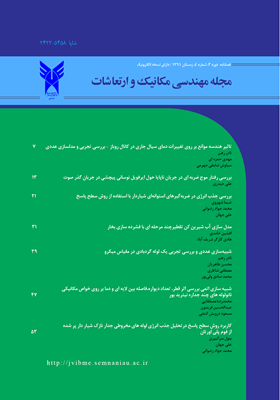بررسی رفتار موج ضربه ای در جریان ناپایا حول ایرفویل نوسانی پیچشی
محورهای موضوعی : مکانیک سیالات
1 - هیئت علمی
کلید واژه: شبکه سازمان یافته, فنر خطی, نوسان پیچشی, شوک ضربه ای, جریان گذر صوت,
چکیده مقاله :
در این تحقیق حل جریان ناپایا با مرز متحرک مورد توجه است. بدین صورت که به بررسی جریان غیر دائم، دو بعدی، تراکم پذیر و غیر لزج حول یک ایرفویل نوسانی با حل معادلات اویلر روی یک شبکه سازمان یافته تطبیق پذیر می پردازیم. با استفاده از شبکه فنری خطی، مش تطبیق پذیری تولید شده است که می تواند چسبیده به سطح جسم، حرکت جسم را مدل کند. در این کار ابتدا به ایجاد شبکه فنری تطبیق پذیر پرداخته و حالات مختلف تولید شبکه تطبیق پذیر را بررسی می کنیم. پس از بررسی استقلال از شبکه و گام زمانی نتایج حاصل با نتایج تجربی مقایسه می شود. همچنین برای نشان دادن مزیت شبکه بندی فوق نتاج با نتایج حاصل ازحالت غیر دائم نوسانات ایر فویل روی یک شبکه بی سازمان مقایسه می گردد. نتایج نشان می دهد که استفاده از شبکه تطبیق پذیر سازمان یافته فنری باعث افزایش سرعت حل در عین حفظ دقت می شود. همچنین مشاهده می شود در حرکت نوسانی پیچشی ایرفویل رفتار شوک کاملاً وابسته به جهت نوسان، زاویه لحظه ای و زاویه متوسط ایرفویل دارد.
In this study, solution of unsteady flows with moving boundaries is considered. So that two dimensional inviscid unsteady and incompressible flow around an oscillating airfoil is investigated by solving Euler equation using structured adaptive grid network. An adaptive grid is produced using linear spring network, which can be attached to the surface of the object and modeled moving surface. The work initially focused on production of adaptive spring grid network and different state of adaptive grid production is investigated. After investigations of mesh and time step independency, the results are compare with experiments. Also, to show the advantages of structured adaptive grid network, the results are compared with unstructured adaptive grid network. The results show that use of adaptive structured network leads to increasing the speed of solution while maintaining the accuracy. Also it can be seen that in pitching airfoil, the shock behavior depends on the direction of movement, instant angle and mean angle of oscillation.


